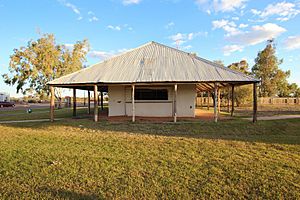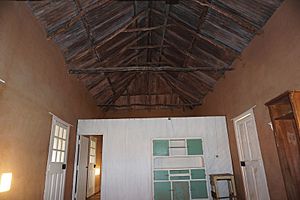Bedourie Pisé House facts for kids
Quick facts for kids Bedourie Pisé House |
|
|---|---|

Bedourie Pisé House, northern side opening, 2016.
|
|
| Location | 5 Herbert Street, Bedourie, Shire of Diamantina, Queensland, Australia |
| Design period | 1870s-1890s Late 19th century |
| Built | 1897,1947 |
| Official name: Bedourie Pisé House and Aboriginal Tracker's Hut; Pisé House; Bedourie Mud Hut | |
| Type | state heritage |
| Designated | 31 May 2019 |
| Reference no. | 650098 |
| Type | Archaeological: Archaeological potential; Law/Order, Immigration, Customs, Quarantine: Other - Law/Order, etc; Residential: Detached house |
| Theme | Working: Surviving as Indigenous people in a white-dominated economy; Building settlements, towns, cities and dwellings: Dwellings; Maintaining order: Policing and maintaining law and order |
| Lua error in Module:Location_map at line 420: attempt to index field 'wikibase' (a nil value). | |
The Bedourie Pisé House is a special heritage-listed building in Bedourie, Queensland, Australia. It was built in 1897 using a unique method called pisé (rammed earth). It's also known as the Bedourie Mud Hut. This site also includes the Aboriginal Tracker's Hut, which was built in 1947. Both buildings tell important stories about life in remote Queensland.
Contents
Bedourie: A Town Built on Trade and Travel
Bedourie is a small, isolated town in central western Queensland. It's located near Eyre Creek, a long way from big cities. For thousands of years, Aboriginal people like the Wangkamadla and Pitta Pitta lived here. They knew how to find water in dry areas using "soaks" or "native wells." These were hollows dug in the ground where water would seep through. Sharing this knowledge was key to survival.
Early European Settlement and Trade Routes
In the 1860s, European settlers arrived, bringing cattle and sheep. Bedourie became important because it was on a trade route between the Georgina and Mulligan rivers. From 1884, Afghan cameleers used this route to transport goods. They followed the same paths Aboriginal people had used for trade. Towns like Bedourie grew as places for rest and supplies.
In 1886, Bedourie was officially named. It means "dust storm." The town was a vital stop for drovers moving cattle. Early businesses, like a general store and hotel, were set up here. These were important for the people living on surrounding cattle stations and for travelers.
Mary Brodie: A Key Figure in Bedourie
The Royal Hotel in Bedourie opened in 1888. A woman named Mary Dolan (later Mary Brodie and Mary Craigie) bought the hotel and other land in 1889. She became a very important person in Bedourie. Running a hotel was one of the few ways women could be independent in the 1800s. Mary was not just a hotel owner; she was also the town's postmistress, storekeeper, and butcher. She helped the small town grow and provided essential services.
Mary ran the businesses even after her first two husbands passed away. She was a strong and resourceful woman. Her hotel served many people, including drovers and those attending Bedourie's annual horse races.
The Bedourie Pisé House: A Unique Home
In 1897, Mary Brodie built the Bedourie Pisé House. It was likely her home and might have even served as a temporary hotel after a storm damaged the original one. This house is special because of how it was built.
What is Pisé Construction?
Pisé de terre, or rammed earth, is an ancient building method. It uses soil (earth with low clay) packed tightly into temporary frames to create strong, rock-like walls. This method was "rediscovered" in France in the 1700s and came to Australia in the 1820s.
Pisé was perfect for western Queensland because building materials were hard to find. There wasn't much timber, and stone was scarce. Pisé was cheaper than brick or wood. It was also great for the hot, dry climate. Pisé houses stayed cool in summer and warm in winter. Many pisé buildings were built in the Channel Country, but most didn't survive. The Bedourie Pisé House is one of the few remaining examples.
Life in the Pisé House
The Pisé House was leased to the Diamantina Shire Council in the early 1900s. Council meetings were held there for many years. It was one of the few buildings in Bedourie, which was still a very small town. Travelers often described Bedourie as an "oasis in the desert" thanks to the hospitality of people like Mary Craigie.
Mary eventually sold her properties and moved away in 1914. The Pisé House was then bought by the Gaffney family. They lived there for many decades. It was known as the "Mud House" or "The Cottage." The family added a generator shed and a bathhouse. In 1940, the house was even called one of the "coolest houses in Queensland" because of its pisé walls.
The house was transferred to the Diamantina Shire Council in 1974. After falling into disrepair, it was restored in the early 2000s. Today, it helps visitors learn about Bedourie's past.
The Aboriginal Tracker's Hut: A Story of Service
Policing in Bedourie began in 1882. Aboriginal trackers were a key part of the police force. They were skilled at finding missing people, tracing criminals, and locating lost animals. Their tracking abilities were amazing and very important in remote areas.
The Role of Trackers
Trackers were employed across Australia from the 1820s. In Queensland, their skills were highly valued. They were given wages, food, and a place to live. Their wives often helped with domestic work at the police station. The Bedourie police station had trackers from 1889. They helped find a murder victim in 1908, a missing man in 1913, and even a lost theatre group in 1940.
Doctor Jack and His Hut
In 1934, a tracker named Doctor Jack came to Bedourie. He was known as a "master horseman and splendid tracker." He and his wife, Norah, built a simple hut for themselves from bush timber and kerosene tins.
By 1945, Doctor Jack's hut was in bad shape. So, in 1947, a new "tracker's quarters" was built for him. This hut was a small, one-room building with a timber frame and corrugated iron walls and roof. It had a dirt floor verandah and a timber floor inside. It was a basic but important home for Doctor Jack and Norah.
Doctor Jack worked as a tracker for about eight years. He eventually left to become a stockman, which offered better pay. Over time, the need for trackers changed, and their numbers in the police service decreased.
The Hut's Journey
The tracker's hut was sold in 1961 and moved to Ethabuka Station. It stayed there until 2004 when it was bought by the Diamantina Shire Council. In 2011, it was moved to its current spot behind the Pisé House.
The Aboriginal Tracker's Hut is one of only a few surviving tracker's huts in Queensland. It helps us remember the vital role Aboriginal trackers played in policing and life in remote Australia.
What You Can See Today
The Bedourie Pisé House and Aboriginal Tracker's Hut are located on Herbert Street. Both are separate buildings.
The Pisé House
The Pisé House is a simple, one-story building. It has thick rammed-earth walls and an earth floor. The roof is made of corrugated metal and extends to form a verandah all around the house. Some of the roof posts are made from natural "bush timber." The house has doors on three sides and a large opening where a fireplace used to be. It has no windows. Inside, a partial wall divides the space into two rooms.
Bathhouse and Generator Shed
Behind the Pisé House, you'll find a basic outbuilding called the Bathhouse and Generator Shed. It's made of timber frames and corrugated metal. The bathhouse has a concrete floor, and the generator shed has an earth floor. Their entrances are simple openings in the walls.
The Aboriginal Tracker's Hut
Near the Bathhouse is the Aboriginal Tracker's Hut. It's a single-room, one-story building with a gable roof. It sits low to the ground on short timber stumps. Its walls and roof are covered with corrugated metal sheets. It has a door facing west and window openings on all four sides. Some windows have shutters made of corrugated iron. The inside is plain, with no wall or ceiling linings.
Both the Pisé House and the Tracker's Hut are important parts of Queensland's history. They show us how people lived, worked, and built homes in remote areas long ago.


